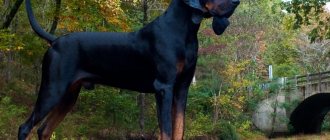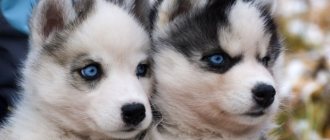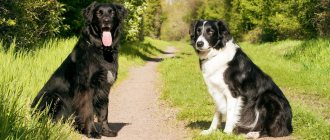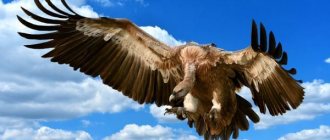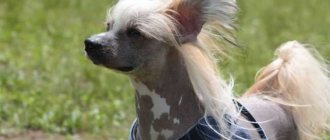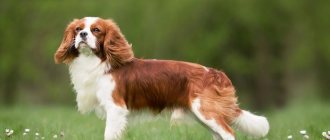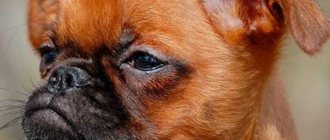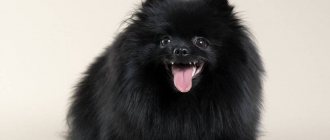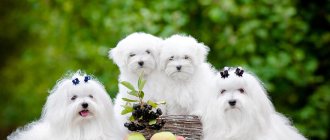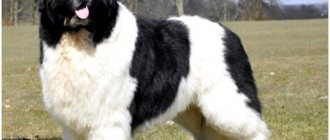The Black and Tan Coonhound is one of a very narrow variety of hunting dogs. These four-legged animals are unique in many characteristics, but the most interesting skill is the ability to catch up and drive a raccoon up a tree.
This is interesting! According to statistics cited by American cynologists, the title “raccoon dog” is awarded to only 1% of Black and Tan Coonhounds; the remaining four-legged dogs are used in driving larger animals or guarding.
History of the Black and Tan Coonhound Breed
The Black and Tan Coonhound is a dog breed that originated in America. There is a possibility that it arose as a result of crossing a Foxhound and a Bloodhound. But there is no clear theory.
The first representatives of the breed appeared in the Appalachian Mountains, and also lived in the Smoky Mountains and Blue Ridge regions. There, with black and tan coonhounds, they successfully hunted raccoons and bears. These dogs, which inherited from their ancestors a perfect scent for the tracks of animals, could pursue and find prey on rough terrain. At the same time, such abilities were preserved even with fast walking and running.
Photo of a black and tan coonhound
Black and Tan Coonhounds can track any animal. But their main specialization is raccoons and possums, so the dogs are well adapted to hunting in the dark. When a dog drives its prey into a trap, it begins to bark loudly. She does not stop giving a signal to the hunter until he comes to this call.
The breed was recognized by the AKC in 1945, but the Black and Tan Coonhound has always been used for hunting rather than as a pet or show dog. In the United States, organized hunting at night is very popular. Therefore, the United Kennel Club organizes separate shows for coonhounds. Not only black and tan hounds participate in them, but also speckled blue, English, and some other representatives of hounds.
The Black and Tan Coonhound is also called the American Coon Dog or Coon Hound. This breed became the only one among the raccoon hounds that was officially recognized. All other Coonhounds are just variations of the Black and Tan.
Historical reference
There is no reliable information about the origin of the breed, but there are a number of quite plausible assumptions. Hounds have always been popular in England. It is reliably known that English dogs were brought to America in the 18th century. The Foxhounds, famous throughout Great Britain, were the favorites of D. Washington and a symbol of the state, so their appearance on the new land was considered a kind of political move. A little later, hound dogs were brought to America from France.
The export of these dogs also had political overtones, emphasizing the loyal relationship between the British and the French. This is how, as a result of political gestures, two types of hounds ended up on the same territory, from which, according to the main version, the older, black and tan variety of coonhounds originated.
This is interesting! Some sources claim that in addition to English and French hounds, Bloodhounds and even Beagles influenced the formation of the breed.
Today, all varieties of Coonhounds are considered rare breeds and are bred (mostly) only in America. In its homeland, this breed is popular because it is regularly used for its intended purpose - hunting raccoons.
Description of the breed
The Black and Tan Coonhound is a hunting dog. Therefore, its main task is to work on rough terrain, both in severe frost and in summer heat. The dog must track the raccoon and drive it up a tree so that it ends up in a trap. The dog does this only with the help of its lower sense. That is, sniffing out the tracks of the beast left on the surface of the earth.
A club that breeds Black and Tan Coonhounds must pay special attention to the breed's working qualities - strength, alertness and energy. Thanks to them, dogs can be used in hunting larger animals such as bears or deer.
Dogs of this breed are distinguished by their ability to make rhythmic and wide jumps, thus moving around the terrain. Therefore, well-developed muscles and strong bones are extremely important for them.
Head
Head. Has clear outlines. The distance from the nose to the occipital protuberance is 23-25 centimeters in males and 20-23 centimeters in females. The skull is rounded, without skin folds.
Muzzle. Well muscled, oblong in shape. If you look at the animal from the side, the upper longitudinal lines of the muzzle and skull will be parallel to each other. The transition from the forehead to the muzzle is moderately expressed, located at an equal distance from the occipital protuberance and the nose.
Ears. They hang down, forming beautiful folds. Located closer to the back of the head.
Nose. The nose is black and quite large. The nostrils are large and open wide.
Mouth. The jaws are strong and the muscles are well developed.
Teeth. The incisors are aligned and the bite is scissor-shaped.
Lips. The wings are present and well developed, like any representative of the hounds. Excessively saggy and “raw” lips are a defect.
Eyes. They may be dark brown or have a nutty hue. Yellow eyes are considered a defect. The expression is meaningful, interested, wary.
Neck. Well muscled, medium length, no dewlap.
Frame
Frame. It has a square shape, the length of the body is equal to the height at the withers or slightly exceeds it. The back is straight and strong.
Breast. The chest is quite deep, reaching to the elbows or even lower. The ribs are convex.
Tail. Located just below the line of the back, quite strong. When at rest, it hangs down; when the animal moves, it rises up and takes a vertical position.
Limbs
The animal's movements are light and graceful. While running, the dog covers a lot of space with its forelimbs and pushes off strongly from the surface with its hind limbs. When looking at a Black and Tan Coonhound from the front, its front legs will move in a straight line without crossing each other. From the rear, the hock joints are in line with the front legs when moving, not close, but not too far apart. When a dog moves quickly, it places its limbs closer to the center of the body.
Front. Shoulders are strong and well developed. The forearms are level, the pasterns are strong and vertical. Paws with well-clenched toes. The pads are thick and fleshy. Flat paws are considered a defect.
Rear. The paws are muscular, with well-developed bones. The lower legs are long with short and strong metatarsals. In the stance, the paws are pulled back and the metatarsals are in a vertical position. The hock and stifle joints are clearly defined. Dewclaws are considered a defect.
Wool
The Black and Tan Coonhound has very dense and coarse guard hair. It protects the animal from any weather and allows you to work in rain, snow, frost and sun. Wool is richly impregnated with special secretions from the skin, which gives it moisture-repellent properties.
Interestingly, the scars that an animal may receive during the hunt do not in any way affect its appearance when assessing its appearance.
Colors
The name of the breed speaks for itself. The main color is black, it is very rich. The tan marks are pronounced and have a contrasting shade. They can be located in the muzzle area, on the eyebrows, chest, paws, and also under the tail.
Too little marking or its complete absence is considered a defect. A white spot on the chest is acceptable, the size of which does not exceed two centimeters. Similar marks on other parts of the body are considered a defect.
Character
Black and Tan Coonhounds are renowned for their hard work and endurance. They are not only tireless, but also know no fear. Therefore, they began to be used as companions in the hunt for larger animals. A well-trained dog will help track down a deer and will not shy away from a puma or a bear.
At the same time, they are very loyal to their owners and treat all other family members kindly. These dogs are always happy to communicate, easy-going and will happily carry out orders given to them. This, of course, applies exclusively to well-mannered animals. You will have to devote a lot of time to training in order to ultimately get an obedient companion and loyal friend.
This dog breed has another character trait - independence. They are able to make decisions independently when necessary. But, if you constantly give this choice to your dog, then you risk getting an uncontrollable and wayward dog. Therefore, during the training process, it is necessary to show patience and perseverance so that the animal obeys you unquestioningly.
This breed gets along well with children. Dogs are very energetic by nature, so they will be happy to play with younger family members. The Black and Tan Coonhound can be taken with you on long walks and involved in any sports games. He will happily jump for a frisbee or run next to a bicycle. If the child is still too small, you need to be careful. This breed is quite large, so the animal can accidentally push the baby and injure him.
The Black and Tan Coonhound can also be used as a watchdog. Its security skills are quite well developed, although the breed is a hunting breed. These dogs are suspicious and wary of all strangers and will keep a watchful eye on their territory.
Black and Tan Coonhounds can get along with other dogs, as representatives of this breed hunt in groups. But your puppy needs to be socialized from birth if you want him to get along with other dogs. But there may be problems with other animals. The dog’s developed hunting instinct, which is almost impossible to suppress, is to blame for everything. Therefore, cats, birds and rodents such as rabbits or chinchillas will be at risk.
Key facts
Every hunter dreams of having a tireless, fast and smart dog. This perfectly coincides with the characteristics of the Estonian hound breed, which is not inferior in work to greyhounds and piebald representatives. And thanks to its small size and weight, sometimes it has no equal in overcoming all kinds of obstacles. This beautiful, mischievous dog is popular not only among hunters. Often representatives of the breed live at home, turning into family members.
Ready to do anything for its owner, the affectionate, friendly Estonian Hound makes an excellent friend. For all her playfulness and mobility, she cannot be called annoying. At home, the pet understands well the boundaries of behavior, coexisting peacefully next to other animals. The dog is very tolerant of children and poses no danger to them.
Education and training
You need to accustom your dog to exercise as soon as it comes into your family. But this should be done extremely carefully, gradually increasing the number and duration of classes. It is very important to take care of your Black and Tan Coonhound's joints, even if you are sure that the animal does not have dysplasia.
Until six months, the dog should not jump from great heights, or run up stairs often and for a long time. To begin strengthening your animal's muscle corset, swimming is ideal. Exercising in water is allowed for any breed of dog, is an excellent prevention of many diseases of the joints and bones, and also has no contraindications.
Not everyone can cope with raising a black and tan coonhound. This dog is quite stubborn by nature. To prevent her from behaving as she pleases, you need to start training the puppy from an early age and clearly indicate to him the boundaries of what is permitted. Do not allow connivance, stand firm in your position, but not aggressively. Physical punishment, like yelling, is unacceptable in raising a Black and Tan Coonhound. Using such methods you will only intimidate the dog and traumatize its psyche. The animal will no longer trust you and may begin to splash out retaliatory aggression on you and others.
From the first days, begin to introduce the puppy to the outside world, doing it gradually. He must understand what poses a real threat to him and what he should not be afraid of. Teach the simplest commands with your puppy:
- "Sit!";
- "Lie!";
- "To me!";
- "Ugh!";
- “Give me your paw!”
Photos of black and tan coonhound training
A puppy can master them already at the age of three months. Don't demand everything from your baby at once. Have patience; you will have to repeat commands more than once to achieve a sustainable result. Even when the dog firmly remembers them, you need to continue to include them in training, supplementing them with more complex options.
To increase the effectiveness of training with your puppy, use treats. Then the dog will not think about whether it needs to carry out this or that command. She will follow her instincts. This way you will ensure that the dog develops a reflex. In the future, he will unquestioningly carry out all your orders. And this is very important for hunting breeds.
The Black and Tan Coonhound was bred for hunting, so its genetics include resistance to difficult weather conditions, endurance, and the ability to work in difficult terrain. The dog's task is to track down prey and drive it into a trap. Since most often this prey is raccoons, trees become their trap. Animals climb on them, escaping from pursuit.
When working, the black and tan coonhound uses only its keen sense of smell. To track down and drive an animal, a dog does not need to use its vision.
Today, hunting can be considered more of a hobby or a kind of sport than a necessity. In America, where the Black and Tan Coonhound breed was developed, there is a tradition. Men go out at night hunting for small fur-bearing animals. Where this occurs, raccoons and opossums are considered pests. Therefore, the authorities do not see anything criminal in such “entertainment”.
All the action begins on the outskirts of the city, where a group of hounds is released. They look for the trail, and when they take it, they begin to chase the animal and bark loudly. The dogs will not subside until the animal is driven up a tree. Each dog has a unique voice that can be recognized not only by its four-legged “partner”, but also by its owner. By the intensity and timbre of barking, you can understand when the dogs are driving their prey into a trap. Then the hunters rush to their destination. Black and tan coonhounds constantly jump, stretching towards the branches on which the animal is located.
In the USA this breed is highly valued. Therefore, working animals with the best skills, which have shown good success in hunting, are used for breeding. For the Black and Tan Coonhound, its working qualities are more important than its exterior.
Hurry up, choose a box and find out what gift awaits you
Discount on pet insurance
Promo code copied to clipboard
Dogs similar to American Coonhounds
Dog breeds similar to the American Coonhound include the American Foxhound, Basenji, and Beagle.
American Foxhound - American Foxhounds are very similar in height and weight to American Coonhounds. One difference is that American Coonhounds are easier to train.
Basenji - Basenjis and American Coonhounds are both very energetic dogs. Basenjis are shorter in size and weigh less than American Coonhounds.
Beagle - Both of these dogs have loyal temperaments and loud barks! American Coonhounds are taller and weigh more than beagles.
Maintenance and care
The Black and Tan Coonhound is not the best breed to keep in an urban environment, especially in an apartment. This may not bother true fans of such beautiful animals if they are ready to take responsibility for the dog. It will be quite difficult to keep her in such conditions.
To feel comfortable, the black and tan coonhound needs a large territory, for which he will be responsible and protect it. But even this will not be enough for the dog to live a full life. He needs to be walked regularly. It is better if it is a wild area where the animal can explore the territory and realize its hunting instincts.
This breed needs regular exercise. Ideally, the dog should be constantly involved in hunting. If this is not possible, then it can be replaced with coursing. This is a type of sport and training during which hunting breeds can show their working qualities by chasing bait or a mechanical hare. If the dog remains inactive, this will negatively affect its mental and physical health.
In addition to physical exercise, the Black and Tan Coonhound must be provided with quality feeding and decent care. The weak point of these dogs is their ears. Due to their special structure and length, they often develop infections. Therefore, special attention should be paid to prevention to avoid serious problems in the future. You need to clean your dog's ears once every two weeks using a special antibacterial lotion. It can be purchased at a pet store or veterinary clinic.
No less attention should be paid to the eyes. Their mucous membranes can become inflamed due to debris, dust or wood chips that get into it during the hunt. When sensing prey, the dog keeps his muzzle low, so sand and blades of grass in the eyes of a black and tan coonhound are not uncommon. They need to be inspected after hunting and training, and also wiped with lotion if necessary.
The older the dog, the more attention its teeth require. In particular, their cleaning. It is better to accustom your pet to this procedure from childhood. You can remove tartar yourself using brushes and special pastes. You can give your dog dental bones, which remove plaque when the dog chews them. This way you can combine business with pleasure. In advanced cases, a veterinarian will help by cleaning the teeth with ultrasound.
If the dog lives in an apartment, then it needs to have its nails trimmed regularly. Don't miss the right moment, otherwise they may injure your fingertips. Dogs kept outdoors have their nails worn down naturally, so they can be trimmed less frequently.
The Black and Tan Coonhound has a short coat with no undercoat. Therefore, he does not need to comb out with a slicker brush. During the shedding period, dogs are cleaned with a stiff brush, and if the animal gets dirty, they are wiped with a towel.
Story
The breed was originally classified and registered as the English Hound and Coonhound before it was split into six varieties.
The recognition of the Coonhound by the United Kennel Club of Bluetick and Treeing Walker in the 1940s led to a change in the classification of the English Coonhound. The breed originated in the southeastern United States, where it was bred from American and English hounds, other European hunting breeds, and native dogs for the purpose of tracking and baiting various animals.
Nutrition
Nutrition for a Black and Tan Coonhound is a very important aspect. It should contain enough protein, at least 75% of the entire diet. Therefore, choose premium or super premium dry or wet food that contains few carbohydrates. This is especially true for those dogs whose activity is limited for one reason or another. Otherwise, there is a risk of developing obesity. And proteins are important for building “lean” muscle mass.
It is important to maintain not only a balanced diet, but also its regimen. An adult dog is given food twice a day, keeping equal intervals between feedings.
The amount of food depends on the dog's activity, weight and age. To correctly calculate the dosage, follow the table that is on each pack of food. The daily norm is usually divided into two equal parts. One of them is fed in the morning, and the second in the evening. For example, it could be 7.00 and 19.00. Any schedule is acceptable, the Black and Tan Coonhound will adapt to your schedule. The main thing is that feeding times are always respected.
Between meals, food should not be in the bowl. If your dog doesn’t finish eating or refuses to eat at all, and you are sure that he is healthy, simply remove the food until the next feeding. Then continue to follow your four-legged friend’s diet. This way you will teach him discipline and also avoid problems with overeating.
Do not forget that the dog is always fed after, and not before, a walk or exercise. Let the dog work up a good appetite. In addition, such actions on the part of the owner help prevent the possibility of gastric volvulus if the animal has a predisposition to it. This is especially true for large breeds of dogs, which include hounds.
In addition, it is difficult for a well-fed dog to perform tricks, long runs and jumps. Interest in the treat offered as a reward decreases.
The Black and Tan Coonhound does not require variety in its diet. Dogs are not people. They don't get bored of eating the same food. It should be well balanced and include all the necessary vitamins and minerals. That is why veterinarians advise giving preference to the highest quality food. With it, the dog will not need to take additional nutritional supplements.
If your pet feels well, then there is no reason to change food. It is better not to “mix” them and feed the dog granules or canned food from only one brand. Otherwise, in case of problems with the gastrointestinal tract or allergies, you will not be able to find out what exactly such a negative reaction was to.
Caring for Coonhounds
Caring for a Coonhound includes food, walking, maintenance and general care.
Food for a Coonhound should be high quality and balanced. The basis is animal proteins (meat) - 75%, so if you feed your dog food, pay attention to the percentage of meat. The food should be at least super-premium class; you can choose one specialized for hunting breeds or active dogs.
What common foods are suitable for a coonhound:
- Carnilove (whole line for dogs);
- Acana (entire line for dogs);
- Orijen (entire line for dogs);
- Summit for large breed dogs;
- AATU for dogs (very high meat content).
Meat is the basis of a dog’s diet
All these foods are gluten and grain free, with a lot of protein, their class is not lower than super-premium. The food is given according to the instructions on the packaging.
Natural food consists of lean meats, vegetables, and porridge. Some owners practice feeding only meat with a small addition of vegetables. This is also possible provided that the dog is given 100–150 g of low-fat cottage cheese per week and 3–4 raw eggs. Otherwise, calcium deficiency may occur. The amount of main food per day is calculated from the ratio of 40–45 g per 1 kg of dog weight.
When feeding natural food, it is a good idea to choose vitamin supplements (be sure to consult a veterinarian!).
The following should not be given to a Coonhound:
- food from the human table;
- spicy, fried, fatty foods;
- onions, garlic, potatoes, cereals, spices, seasonings;
- sweets (especially chocolate);
- pork and sea fish.
Food is the basis of a dog's health
You need to walk your coonhound at least 2 times a day for 1.5–2 hours. The walk should be active. You can optimally exercise your dog by teaching it to run next to a bicycle. But don’t forget that the dog not only needs to run, but also play with the owner and learn new things. Try, if possible, to change walking routes more often, so the dog will not get bored. It is best to keep a coonhound in a private house with a garden area. But a spacious apartment is also suitable, provided that the dog is walked a lot.
You don't need to wash your Coonhound more than 2-3 times a year. Short hair requires weekly brushing with a thick brush. Coonhound ears require special attention. They need to be examined more often so as not to miss an infection, the inner surface should be wiped daily with a napkin with a special lotion for cleaning dog ears, and the inside should be cleaned with it once every 5 days.
Since coonhounds, like all hunting breeds, love to roll around in something smelly (thus hiding their smell), frequent washing is necessary. My dog, although not a hunter, loves to give his owner “pleasant” surprises. But washing a dog with shampoo often is not very useful, so I found a very effective recipe from a breeder I know. You need to take clean sand and add a few drops of eucalyptus or lavender oil to it (not very much, just to remove the smell). Okay, but gently rub the dog, leave for 5 minutes and rinse. Sand will remove all dirt, and oil will remove unpleasant odors. It only helps those with short hair, because it is difficult to wash sand out of long hair.
Coonhounds, like all hunting dogs, love to roll around in odorous substances.
Health of Black and Tan Coonhounds
On average, the Black and Tan Coonhound lives between 10 and 12 years. In general, these dogs are in good health. But there are some nuances. If you want to purchase a puppy of this breed, then contact experienced and trusted breeders or well-known nurseries. Black and Tan Coonhounds have hereditary diseases that are quite severe:
- Hip dysplasia. This defect can be either congenital or age-related. Because of it, the joints take on an irregular shape and function poorly. It is believed that this disease is inherited. If the parents have not been diagnosed with dysplasia, then everything will be fine with the puppy. Today, there are a number of examinations that can reveal a dog’s predisposition to this defect even in puppyhood. Therefore, many progressive breeders provide buyers with the appropriate documents.
- Heart disease. This diagnosis has a collective concept. It means that there is a congenital or acquired defect in the heart muscle. In the first case, it will be noticeable already at birth. In the second, it may appear after the dog has suffered from an illness, excessive stress, stress, or unsatisfactory living conditions.
- Hemophilia B. This is a hereditary disease that disrupts the composition of an animal's blood. Receiving even a minor wound, it can die from blood loss, since it does not clot and does not stop.
The Black and Tan Coonhound has a special build of the body and skull, so another “weak” area can be considered the eye area, or more precisely, the eyelids. They can be folded in or out. This problem may be congenital or may manifest itself during the puppy’s growth period. The good news is that this defect can be easily corrected with simple surgery. If you leave everything to chance, then with age the dog may develop progressive retinal atrophy (PRA). The animal will begin to rapidly lose visual acuity and may become completely blind.
Long ears are prone to infections and ear infections. With proper care there will be no problems. But advanced cases develop into chronic ones and torment the dog constantly.
Like all dogs, the Black and Tan Coonhound must be vaccinated according to its vaccination schedule. This is very important, since the dog comes into contact with wild animals during the hunt.
Mating for females is recommended from 20 months, and for males - from 18. Mating is possible after 3-4 cycles. Bitches come into heat every 7-8 months. Fertilization is possible on days 10-14 of the cycle. It is on these dates that the first mating is carried out, and a control mating is scheduled a day or two later. Pregnancy in the Black and Tan Coonhound lasts 56-72 days. About 7 puppies are born in a litter.
Coonhound diseases
Coonhounds are strong, tough and healthy breeds that have not been inbred and bred from equally strong hunting breeds. The lifespan of a family dog is rarely less than 14 years; hunting dogs live 10–12 years. The breed has few diseases, but there are some predispositions.
Obesity
Many hunting breeds are susceptible to it because they need movement. If it is not enough, the dog naturally gains weight.
How to recognize obesity:
- inability to feel the ribs and spine through the layer of fat;
- it is difficult for the dog to walk, shortness of breath appears after minor exertion;
- problems with the heart and joints begin;
- The dog is rapidly gaining weight and eating more and more.
Coonhounds are prone to obesity
To prevent obesity you need to:
- Buy a scale for your dog and closely monitor weight changes. This will allow you to quickly adjust your diet.
- Watch your diet, do not feed more than normal.
- Do not feed the dog uncontrollably, do not give it treats outside of feeding and training.
- Treats are included in the daily diet and, if they are not fruits or vegetables, are deducted from the daily diet.
- Lead an active lifestyle with your dog.
Treatment is prescribed by a veterinarian. It consists of diet, exercise regimen and, in some cases, hormonal medications.
Ear infections
All dogs with floppy ears are susceptible to them, as infections thrive in enclosed, warm, humid areas. Main symptoms:
- severe scabies;
- the appearance of scratches and crusts;
- increased temperature of the ears;
- unpleasant odor;
- purulent discharge;
- negative reaction when touched;
- bending and shaking your head in a certain direction becomes especially noticeable while running.
Ear hygiene is the best prevention of ear infections
Prevention - ear hygiene, taking antiparasitic drugs. Treatment is medicinal, prescribed by a veterinarian depending on the infection.
Dysplasia
The term “dysplasia” refers to any deviation from the norm in the condition of a joint: destruction of cartilage or bone, cracks, defects, etc. Large breed dogs and dogs with a genetic predisposition are susceptible to dysplasia. Main symptoms:
- lameness or change in gait;
- decreased activity;
- swelling of the paw;
- stiffness in movements;
- inability to lean on the paw.
Treatment of dysplasia depends on the degree of neglect. Mild forms are treatable with physical therapy and medications. Severe forms can only be cured by surgery or hip replacement.
To prevent joint injuries in puppies, you need to dose the loads
Photos of black and tan coonhounds
Who are black and tan coonhounds suitable for?
Obviously, this dog breed is best suited for people who are interested in hunting. After all, the Black and Tan Coonhound was bred precisely for these purposes. You could say that this is his purpose.
If hunting is not part of your plans, then it is better to own this breed for those who are willing to devote a lot of time and effort to the dog. It is suitable for an adult, consistent and balanced person who understands training and will not take out his anger on an animal.
If you do not have time for long walks, trips out of town and visits to the dog handler, then it is better to choose another puppy. A black and tan coonhound may not be the best option if you have cats or other animals in your home. Most likely, the hunter's instinct will sooner or later take over, even if the dog is trained.
Those who want to get a puppy of this breed should also remember that this dog has a very loud and sonorous bark. This is another disadvantage for those who live in a multi-storey building. In addition, an apartment will not be the best option for maintenance. For such a large dog, a private house with a large fenced area is suitable, where the dog can splash out his energy.
Despite their short coat, black and tan coonhounds tolerate cold and heat well. Therefore, the dog will be happy in an enclosure and a wooden booth.
Advantages and disadvantages
Advantages of the breed:
- endurance, ability to overcome long distances;
- sociability, friendly character;
- kind attitude towards children;
- getting along with other pets;
- neatness;
- quick wit, high intelligence;
- good guard qualities.
Flaws:
- the need for frequent walking;
- the impossibility of year-round maintenance in an enclosure;
- excessive excitability;
- low popularity of the breed.
How to choose a puppy
If you are going to actively use an adult dog for hunting, then the puppy must be purebred, from working parents.
Make an appointment with whoever is offering the puppy. You will be able to ask this person all the questions you are interested in, see in what conditions the babies and their mother are kept. Do not buy puppies secondhand from spontaneous markets. No one can guarantee that the baby is healthy. In addition, the Black and Tan Coonhound is a fairly rare breed that is not carried by many breeders. The likelihood that a mestizo will be “slipped” to you at the market is very high.
Renowned breeders offer healthy and purebred puppies from renowned parents. Children are vaccinated according to age and have all the necessary documents. In addition, breeders are willing to help new owners with advice and support at first.
Characteristics of the Coon Hound
| Attachment level | High |
| Friendliness | High |
| For children | High |
| Accommodation with other animals | Average |
| Exercise needs | High |
| Playfulness | High |
| Energy level | High |
| Learning ability | Average |
| Intelligence | Average |
| Tendency to bark | High |
| Shedding amount | Low |
